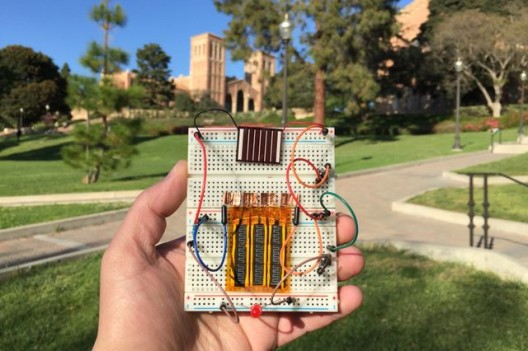Now here’s a mission statement. “Engineering three-dimensional hybrid supercapacitors and microsupercapacitors for high-performance integrated energy storage.”
Conventional wisdom says that super and ultracapacitors don’t have the energy storage of batteries, and even given their outstanding ability to deliver power at high levels pretty much instantly, will never be able to run an electric vehicle for extended periods. So many researchers, with the notable exception of Dr. Richard Kaner and graduate student Maher El-Kady at UCLA have turned their attention to batteries, and not capacitors.
They recognize that electronic devices have improved immensely over the past decades, but “the slow pace of battery development has held back technological progress.”
Looking to synthesize rather than differentiate, the two California NanoSystems Institute researchers have “successfully combined two nanomaterials to create a new energy storage medium that combines the best qualities of batteries and supercapacitors,” according to their UCLA Newsroom announcement.
Their combined components can charge in seconds and be used for “more than 10,000 recharge cycles,” essentially a lifetime battery with over 27 years of daily recharges. The researchers admit to a major failing, though. The hybrid supercapacitor normally can’t store enough energy to run our electronic devices.
Their study, “Engineering three-dimensional hybrid supercapacitors and microsupercapacitors for high-performance integrated energy storage,” was published in the Proceedings of the National Academy of Sciences. Co-authors include Maher F. El-Kady, Melanie Ihns, Mengping Li, Jee Youn Hwang, Mir F. Mousavi, Lindsay Chaney, Andrew T. Lech, and Richard B. Kaner.
Although the current device exhibits energy density equivalent to lead-acid batteries, that’s not yet good enough for electric vehicle use. El-Kady remains optimistic, “The microsupercapacitor is a new evolving configuration, a very small rechargeable power source with a much higher capacity than previous lithium thin-film microbatteries,”
The hybrid storage device combines laser-scribed graphene, or LSG with manganese dioxide. LSG can hold an electrical charge, is very conductive, and charges and recharges very quickly. It’s used in alkaline batteries because of its capacity to hold a charge and its inexpensive abundance.
According to UCLA, “They can be fabricated without the need for extreme temperatures or the expensive ‘dry rooms’ required to produce today’s supercapacitors.”
Kaner and El-Kady found the supercapacitor could quickly store the electrical charge from a solar cell during the day, hold that charge and then power an LED overnight. This would be useful for off-grid lighting of all kinds, but shows the potential of the supercapacitor as an energy storage device.
Kaner explains, “The LSG–manganese-dioxide capacitors can store as much electrical charge as a lead acid battery, yet can be recharged in seconds, and they store about six times the capacity of state-of-the-art commercially available supercapacitors. This scalable approach for fabricating compact, reliable, energy-dense supercapacitors shows a great deal of promise in real-world applications, and we’re very excited about the possibilities for greatly improving personal electronics technology in the near future.”
Their research led the CNSI scientists to device a microsupercapacitor small enough to fit in wearable or implantable devices. Even though it’s only one-fifth the thickness of a sheet of paper, it can hold more than twice the charge of a typical thin-film lithium battery.
Kaner adds, “Let’s say you wanted to put a small amount of electrical current into an adhesive bandage for drug release or healing assistance technology. The microsupercapacitor is so thin you could put it inside the bandage to supply the current. You could also recharge it quickly and use it for a very long time.”
This research was supported by Nanotech Energy.

